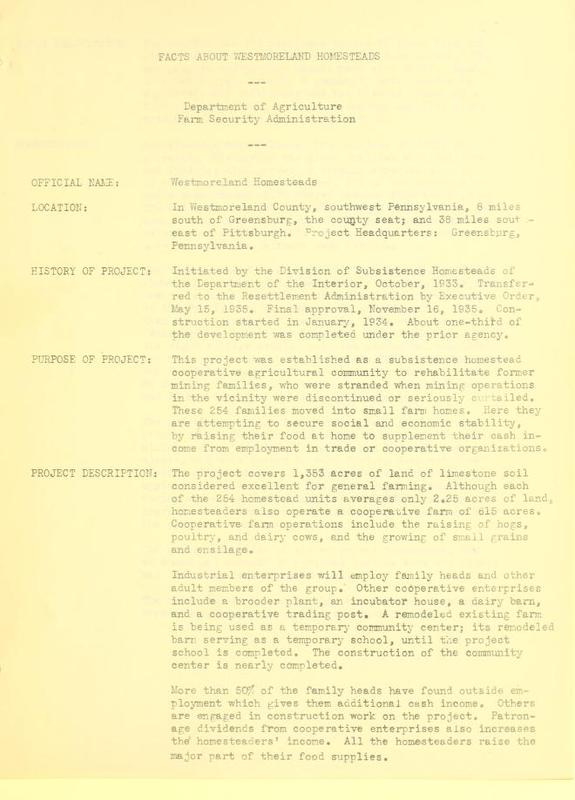Facts about Westmoreland Homesteads
Title
Facts about Westmoreland Homesteads
Subject
subsistence homesteads
Excerpt
This project was established as a subsistence homestead cooperative agricultural community to rehabilitate former mining families, who were stranded when mining operations in the vicinity were discontinued or seriously curtailed. These 254 families moved into small farm homes. Here they are attempting to secure social and economic stability, by raising their food at home to supplement their cash income from employment in trade or cooperative organizations.
PROJECT DESCRIPTION: The project covers 1,353 acres of land of limestone soil considered excellent for general farming. Although each of the 254 homestead units averages only 2.25 acres of land homesteaders also operate a cooperative farm of 615 acres. Cooperative farm operations include the raising of hogs, poultry, and dairy cows, and the growing of small grains and ensilage.
Industrial enterprises will employ family heads and other adult members of the group. Other cooperative enterprises include a brooder plant, an incubator house, a dairy barn, and a cooperative trading post. A remodeled existing farm is being used as a temporary community center; its remodeled barn serving as a temporary school, until the project school is completed. The construction of the community center is nearly completed.
More than 50% of the family heads have found outside employment which gives them additional cash income. Others are engaged in construction work on the project. Patronage dividends from cooperative enterprises also increases the homesteaders' income. All the homesteaders raise the major part of their food supplies.
PROJECT DESCRIPTION: The project covers 1,353 acres of land of limestone soil considered excellent for general farming. Although each of the 254 homestead units averages only 2.25 acres of land homesteaders also operate a cooperative farm of 615 acres. Cooperative farm operations include the raising of hogs, poultry, and dairy cows, and the growing of small grains and ensilage.
Industrial enterprises will employ family heads and other adult members of the group. Other cooperative enterprises include a brooder plant, an incubator house, a dairy barn, and a cooperative trading post. A remodeled existing farm is being used as a temporary community center; its remodeled barn serving as a temporary school, until the project school is completed. The construction of the community center is nearly completed.
More than 50% of the family heads have found outside employment which gives them additional cash income. Others are engaged in construction work on the project. Patronage dividends from cooperative enterprises also increases the homesteaders' income. All the homesteaders raise the major part of their food supplies.
Creator
Farm Security Administration
U.S. Department of Agriculture
Date
n.d.
File(s)
Facts about Westmoreland Homesteads 1.jpg
(image/jpeg)
Facts about Westmoreland Homesteads 2.jpg
(image/jpeg)
 An official website of the United States government.
An official website of the United States government.



